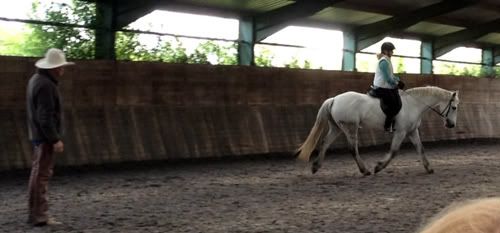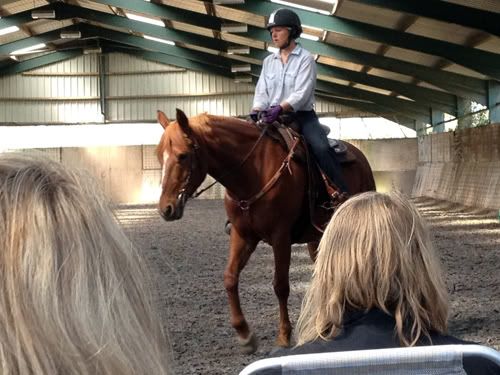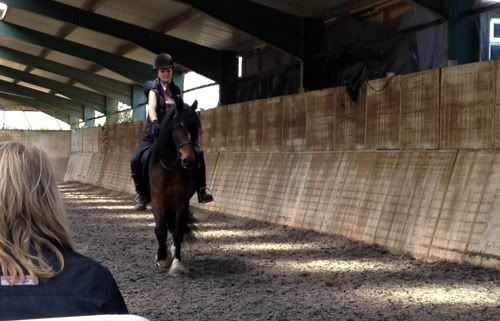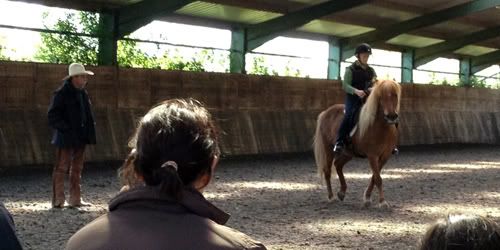Post by Elaine on May 11, 2012 19:00:06 GMT
DAY 1: KATE AND GOU - wants to fix canter to trot transitions
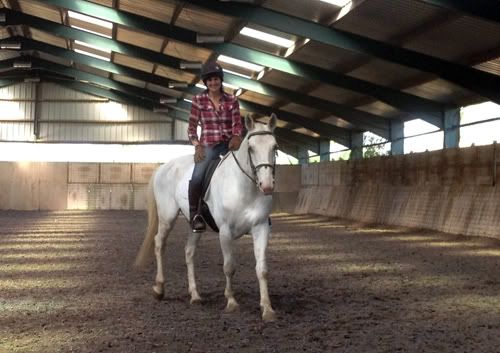
Mainly done groundwork due to physical issues. Gorgeous Lipizanner!! This team have put in a TON of hard work in schooling and also health issues to get there. Super work & the horse just adores Kate
Kate said she can get GOU into canter but to get him back to trot she needs to circle him on one rein a few times. She wanted to get him more relaxed and less anxious. He can also spook badly. GOU has had physical issues so most of theory done so far has been groundwork.
First up, Kate demos the canter to trot transition, using spirals to slow GOU down. Mark asks ' what's you're backup from halt like?' GOU hasn't done this much, first time was earlier this week. Some foundations were missing. If the stop is not good in walk and trot you won't have a stop in canter. Also, GOU is not breathing when he canters. He is not enjoying cantering.
GOU was asked to backup. When he raised up his head, he got some slack in the reins and found a release, but this wasn't the behaviour you want to encourage. The horse was a little confused. Also Mark said if you get an injury, youngest more protective of that area of your body in the future.
Then Mark explained something:
Imagine you're walking down the street and you see a person who makes you feel unsafe or uneasy.
1. Your mind says its ok, we have laws, police etc, nothing will happen. Your body disagrees and goes on alert.
2. When a threat occurs, your body reacts. Blood rushes to your core, other systems not necessary at at time shut down, eg. Digestive systems. In this situation, you run away from threat.
3. Once you are free from the threat, your body stats to return to normal, through heavy breathing.
4. Then your body shakes, and then you area back to normal.
It's easy to teach your horse to live In hypertension. Mark said he could work on the canter but there are other things he could do as well to help GOU out. There is a lot of brace in the horse. (tense muscles).
PLAN: work on the foundations. Beginning with Stop and backup.
- at halt, pick up reins. Am for a soft feel and then release.
- focus on the initial contact, so the horse doesn't feel like he has to fight against it
- backup - use almost no pressure, but enough to complete the task. And inside the pressure is softness.
1st backup: release only when you get what you want.
2nd backup: HUGE improvement!!!
Tried a walk to halt. GOU braces when he stops.
When you backup you want the whole body to unlock, like it's effortless. The horse will then be using his back end.
Mark emphasised more than once that the initial contact you make with the rein is CRITICAL. This will decide whether the horse will fight you or not.
HUMAN TO HUMAN EXERCISE
Both of you hold the reins, one is the human, one is the horse. If one person let's go, and the other persons hands move back, the other person was pulling. DO NOT PULL!! Try again until when then pretend horse releases, your hands do not pull backwards to you.
When you pick up the reins, do not put tension in your arms. Feel comes from inside of you. The inside of a person has to soften, to get soft feel in your hands, to soft feel in the inside of the horse to then show in the outside of the horse. How to start all of this? Breathe.
QUESTION:
When you get up on your horse, do you feel a twinge of fear? Fear of riding, perhaps fear of not doing the right thing for your horse? Replace this with a feel of gratitude instead.
Deal with the inside of the rise, not just the outside of the horse.
What to do if a human or horse is pulling on you via a rope or rein. Mark demoed this many times today and pretty much amazed everyone. Think about moving your hands to the horse / human, but don't do it. This actually makes it IMPOSSIBLE for someone to pull against you. Then you can move them in a direction.
TOP TIP OF THE DAY: to open any jar, turn it and EXHALE. The lovely Karen learned this from Mark 8 years ago and she swears its worked on every pasta jar since then
IMPORTANT : BACKUP WITH SOFTNESS
- the initial contact, do not grab
- the feeling on the reins has to come from inside of you
- then think (only think!!!) about backing.
- when you've backed enough then think (only think!!!) of stopping
HALT: what the horse does after he stops his feet is as important as the actual stopping of his feet. You NEED a soft halt. The horse has been taught to stop braced. He gets a release for this. Only release after you get a soft feel, not just when the feet stop moving. After the halt, this horse instead of being soft, outs his head up in the air to get a release. (not what you want).
Someone only touching the reins can create a feeling of self defence in a horse.
Lovey work from GOU and Kate. Walk to halt with soft feel, then release the reins. Much better, tension in both horse and rider is reduced. Also Gous walk is now much more relate and slower than usual.
If you don't give your horse something to fight against, he won't fight.
There is strength in your muscles. You can fight strength. But there is power in softness. You can't fight softness.
If you can change how the horse feels, you can change what the horse does.
A brilliant job by Kate & Gou. A super team, and what a horse!!
DAY 2: KATE AND GOU
Gou looks different today. Relaxed & more setttled. He stretches his head down when standing still & pulls on the reins. Mark says 'if you horse puts his head down low, hold just one rein. Then he can't pull the reins out of your hands, instead he causes his own head to turn sideways, and doesn't get a release.' Good tip.
Nice walk & trot. Ooohh lovely trot there!! No rushing into canter. Easygoing, everything looks soft & nice.
Mark said - in rising trot, Kate is riding from her upper chest, this is taking Kate out of balance and onto the horses shoulders, tipping forwards. Kate has to rise from her core instead.
Transitions - don't think of going from a walk to a trot. Think of going from a 4 beat to a 2 beat. Think of it in terms of rhythm. Wow another lovely relaxed trot!
"Don't worry about how your horses transitions will look like. Instead just make sure you do YOUR transition like how you want it to feel."
When Kate thinks 'trot-walk' (only thinks!!!) Gou's body changes STRAIGHT AWAY.
Breathe out on upwards transitions. If you inhale and hold your breath on transitions, your horse will find it more difficult. When you do ANYTHING - breathe out.
Gou is now only using the muscles he needs to trot. He is not using any extra muscles. Gorgeous relaxed, soft trot!! This horse wants to work with his rider at a higher level. Nice trot, lovely transition, lovely forwards walk.
Currently, we are not talking about how much of an aid to apply. We are talking about how much to THINK about what we'd like our horse to do. From now on, we have to move on to HOW IT FEELS. Your mind has to kick into what your body already knows how to do.
If you can get your trot good, your canter will be easy. Do lots of speeds of trot. Get the trot fast enough to just below canter. Then slow down the trot, without picking up the reins. Gorgeous fast & slow trot there from Kate & Gou. Woohoo now we've got canter! Nice canter to trot, horse really trying. Kate has to remember to keep breathing. Gou just floated from canter to trot there.
Ride your horse with relaxation and your horse will last longer.
Don't say - 'my horse does x, y & z'. You've got to say 'we do x, y & z'. The human has to take on some of the responsibility. Its not about blame or fault. It's about figuring out what we can do to improve it.
Mark talked a lot about creating an opening and softness coming from inside.
EXERCISE: Softness from within
A line of 7 people were standing in a row holding hands. Mark was number 4, right in the middle. Three people on either side of him were pulling away from him. Mark softened and was able to pull the SIX PEOPLE back towards him!!!
DAY 3: KATE AND GOU
Today Kate wanted more power from Gou, but not rushing. This horse has physical issues (kissing spines), and Mark said he may feel like he has to rush to stay balanced when trying to use more power.
TROT: Choose one hind foot. Think of getting one hind foot to reach under more to where you are sitting (easiest to focus on the inside hind when you are riding in trot). This should lengthen the stride - VERY nice!
If a horse is unbalanced, more rider leg will equal faster, not a more powerful gait. If you can get your more better balanced, everything else he will be much better able to do.
CANTER: Do a few canter strides then come back to trot, to encourage horse to mentally check in with Kate while in canter and not to zone out, and be mentally miles away when cantering. A good bit of time spent on this. Good on one rein, worked on the other rein. BIG improvement - just do 3 canter strides, then ask back to trot, then the horses was listening to Kate MUCH more in canter.
All horses will respond to a thought. Some may take longer than others due to how they were trained.
GORGEOUS big trot there from Gou.
Kate has to breathe out when she does transitions. 3 canter strides, then back to trot. Repeat lots of times. GREAT!! Kate is getting Gou to where he has to THINK. GO back to a slow trot or a walk in between canters, to make sure GOU relaxation level stays as it is. Get his energy level to drop & relax. Just got an amazing relaxed - TROT - CANTER - TROT - WALK there.
Brilliant stuff, an amazing partnership. GOU is WAY more relaxed in trot & canter, like a different horse. Gou is now thinking back to his human in all gaits.
WELL DONE KATE & GOU!!!

Mainly done groundwork due to physical issues. Gorgeous Lipizanner!! This team have put in a TON of hard work in schooling and also health issues to get there. Super work & the horse just adores Kate

Kate said she can get GOU into canter but to get him back to trot she needs to circle him on one rein a few times. She wanted to get him more relaxed and less anxious. He can also spook badly. GOU has had physical issues so most of theory done so far has been groundwork.
First up, Kate demos the canter to trot transition, using spirals to slow GOU down. Mark asks ' what's you're backup from halt like?' GOU hasn't done this much, first time was earlier this week. Some foundations were missing. If the stop is not good in walk and trot you won't have a stop in canter. Also, GOU is not breathing when he canters. He is not enjoying cantering.
GOU was asked to backup. When he raised up his head, he got some slack in the reins and found a release, but this wasn't the behaviour you want to encourage. The horse was a little confused. Also Mark said if you get an injury, youngest more protective of that area of your body in the future.
Then Mark explained something:
Imagine you're walking down the street and you see a person who makes you feel unsafe or uneasy.
1. Your mind says its ok, we have laws, police etc, nothing will happen. Your body disagrees and goes on alert.
2. When a threat occurs, your body reacts. Blood rushes to your core, other systems not necessary at at time shut down, eg. Digestive systems. In this situation, you run away from threat.
3. Once you are free from the threat, your body stats to return to normal, through heavy breathing.
4. Then your body shakes, and then you area back to normal.
It's easy to teach your horse to live In hypertension. Mark said he could work on the canter but there are other things he could do as well to help GOU out. There is a lot of brace in the horse. (tense muscles).
PLAN: work on the foundations. Beginning with Stop and backup.
- at halt, pick up reins. Am for a soft feel and then release.
- focus on the initial contact, so the horse doesn't feel like he has to fight against it
- backup - use almost no pressure, but enough to complete the task. And inside the pressure is softness.
1st backup: release only when you get what you want.
2nd backup: HUGE improvement!!!
Tried a walk to halt. GOU braces when he stops.
When you backup you want the whole body to unlock, like it's effortless. The horse will then be using his back end.
Mark emphasised more than once that the initial contact you make with the rein is CRITICAL. This will decide whether the horse will fight you or not.
HUMAN TO HUMAN EXERCISE
Both of you hold the reins, one is the human, one is the horse. If one person let's go, and the other persons hands move back, the other person was pulling. DO NOT PULL!! Try again until when then pretend horse releases, your hands do not pull backwards to you.
When you pick up the reins, do not put tension in your arms. Feel comes from inside of you. The inside of a person has to soften, to get soft feel in your hands, to soft feel in the inside of the horse to then show in the outside of the horse. How to start all of this? Breathe.
QUESTION:
When you get up on your horse, do you feel a twinge of fear? Fear of riding, perhaps fear of not doing the right thing for your horse? Replace this with a feel of gratitude instead.
Deal with the inside of the rise, not just the outside of the horse.
What to do if a human or horse is pulling on you via a rope or rein. Mark demoed this many times today and pretty much amazed everyone. Think about moving your hands to the horse / human, but don't do it. This actually makes it IMPOSSIBLE for someone to pull against you. Then you can move them in a direction.
TOP TIP OF THE DAY: to open any jar, turn it and EXHALE. The lovely Karen learned this from Mark 8 years ago and she swears its worked on every pasta jar since then

IMPORTANT : BACKUP WITH SOFTNESS
- the initial contact, do not grab
- the feeling on the reins has to come from inside of you
- then think (only think!!!) about backing.
- when you've backed enough then think (only think!!!) of stopping
HALT: what the horse does after he stops his feet is as important as the actual stopping of his feet. You NEED a soft halt. The horse has been taught to stop braced. He gets a release for this. Only release after you get a soft feel, not just when the feet stop moving. After the halt, this horse instead of being soft, outs his head up in the air to get a release. (not what you want).
Someone only touching the reins can create a feeling of self defence in a horse.
Lovey work from GOU and Kate. Walk to halt with soft feel, then release the reins. Much better, tension in both horse and rider is reduced. Also Gous walk is now much more relate and slower than usual.
If you don't give your horse something to fight against, he won't fight.
There is strength in your muscles. You can fight strength. But there is power in softness. You can't fight softness.
If you can change how the horse feels, you can change what the horse does.
A brilliant job by Kate & Gou. A super team, and what a horse!!

DAY 2: KATE AND GOU
Gou looks different today. Relaxed & more setttled. He stretches his head down when standing still & pulls on the reins. Mark says 'if you horse puts his head down low, hold just one rein. Then he can't pull the reins out of your hands, instead he causes his own head to turn sideways, and doesn't get a release.' Good tip.
Nice walk & trot. Ooohh lovely trot there!! No rushing into canter. Easygoing, everything looks soft & nice.
Mark said - in rising trot, Kate is riding from her upper chest, this is taking Kate out of balance and onto the horses shoulders, tipping forwards. Kate has to rise from her core instead.
Transitions - don't think of going from a walk to a trot. Think of going from a 4 beat to a 2 beat. Think of it in terms of rhythm. Wow another lovely relaxed trot!
"Don't worry about how your horses transitions will look like. Instead just make sure you do YOUR transition like how you want it to feel."
When Kate thinks 'trot-walk' (only thinks!!!) Gou's body changes STRAIGHT AWAY.
Breathe out on upwards transitions. If you inhale and hold your breath on transitions, your horse will find it more difficult. When you do ANYTHING - breathe out.
Gou is now only using the muscles he needs to trot. He is not using any extra muscles. Gorgeous relaxed, soft trot!! This horse wants to work with his rider at a higher level. Nice trot, lovely transition, lovely forwards walk.
Currently, we are not talking about how much of an aid to apply. We are talking about how much to THINK about what we'd like our horse to do. From now on, we have to move on to HOW IT FEELS. Your mind has to kick into what your body already knows how to do.
If you can get your trot good, your canter will be easy. Do lots of speeds of trot. Get the trot fast enough to just below canter. Then slow down the trot, without picking up the reins. Gorgeous fast & slow trot there from Kate & Gou. Woohoo now we've got canter! Nice canter to trot, horse really trying. Kate has to remember to keep breathing. Gou just floated from canter to trot there.
Ride your horse with relaxation and your horse will last longer.
Don't say - 'my horse does x, y & z'. You've got to say 'we do x, y & z'. The human has to take on some of the responsibility. Its not about blame or fault. It's about figuring out what we can do to improve it.
Mark talked a lot about creating an opening and softness coming from inside.
EXERCISE: Softness from within
A line of 7 people were standing in a row holding hands. Mark was number 4, right in the middle. Three people on either side of him were pulling away from him. Mark softened and was able to pull the SIX PEOPLE back towards him!!!
DAY 3: KATE AND GOU
Today Kate wanted more power from Gou, but not rushing. This horse has physical issues (kissing spines), and Mark said he may feel like he has to rush to stay balanced when trying to use more power.
TROT: Choose one hind foot. Think of getting one hind foot to reach under more to where you are sitting (easiest to focus on the inside hind when you are riding in trot). This should lengthen the stride - VERY nice!
If a horse is unbalanced, more rider leg will equal faster, not a more powerful gait. If you can get your more better balanced, everything else he will be much better able to do.
CANTER: Do a few canter strides then come back to trot, to encourage horse to mentally check in with Kate while in canter and not to zone out, and be mentally miles away when cantering. A good bit of time spent on this. Good on one rein, worked on the other rein. BIG improvement - just do 3 canter strides, then ask back to trot, then the horses was listening to Kate MUCH more in canter.
All horses will respond to a thought. Some may take longer than others due to how they were trained.
GORGEOUS big trot there from Gou.
Kate has to breathe out when she does transitions. 3 canter strides, then back to trot. Repeat lots of times. GREAT!! Kate is getting Gou to where he has to THINK. GO back to a slow trot or a walk in between canters, to make sure GOU relaxation level stays as it is. Get his energy level to drop & relax. Just got an amazing relaxed - TROT - CANTER - TROT - WALK there.
Brilliant stuff, an amazing partnership. GOU is WAY more relaxed in trot & canter, like a different horse. Gou is now thinking back to his human in all gaits.
WELL DONE KATE & GOU!!!

